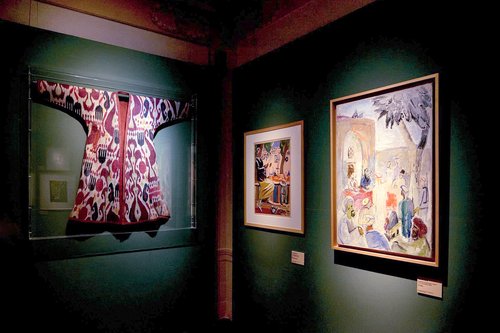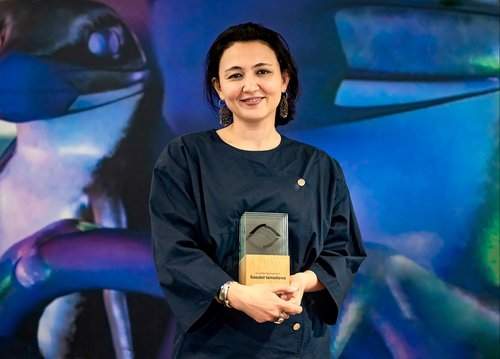Kirill Richter & Richter Trio and National Symphony Orchestra of Uzbekistan. Sands of Time. London, 2024. Courtesy of London Coliseum
Uzbekistan Dazzles Audiences in London
The Uzbekistan Art and Culture Development Foundation has staged two events at London’s Coliseum this September. The world premiere of ‘Sands of Time’ a multi-media performance by millennial composer Kirill Richter followed by ‘Lazgi—Dance of Soul and Love’, by the National Ballet of Uzbekistan.
Composer and pianist Kirill Richter (b. 1989) appeared on stage dressed in a sequined waistcoat à la Elton John beside violinist Alena Zinovieva and cellist Avgust Krepak, the three performers surrounded by seven towering screens that projected swirling images reminiscent of currents of air, rhythmic waves, clocks, flowing sand. All visual accompaniments which enhance what is Richter’s hallmark of simple yet expressive music with poetic melancholy and almost bereft of any mannerism – musical compositions which an AI chat bot today might describe as an organic fusion of the rational and the emotional.
‘Sands of Time’ is not abundant in harmonic collisions or sweeping melodic arcs; its essence lies in movement. As a composer, Richter manages with minimalistic yet traditional means to infuse his music with a kind of raw authenticity and energy where dialogues with classicism and the late baroque are enriched with contemporary flourishes. His melodies, while dominant throughout, rarely unfold into extended development, instead Richter relies mostly on the power of expression and a percussive piano technique with which he blurs the sound and heightens emotional impact.
‘Sands of Time’ is divided into three acts, the first consisting of twelve pieces which have an almost identical structure and attempt to reveal the physicality of music, echoing the projections at the back of the stage and natural phenomena. Richter, Zinovieva, and Krepak, known as the Richter Trio, converse with one another in a language of partnership and mutual support, their synergy a shared vision. Zinovieva and Krepak are musicians who have thoroughly explored the timbral possibilities of their instruments. Zinovieva’s measured bow movements often fill compositions with excitement culminating in moments of electric brightness, her violin mimicing the euphoria of a Fender Stratocaster. Krepak coaxes an impressive spectrum of percussive sounds from his cello with clicks, clacks, and creaks that evoke everything from shattering glass to the rhythmic churn of locomotive wheels.
The Richter Trio alone creates a full-bodied and fluid sound, then in the second act they are joined by the National Symphony Orchestra of Uzbekistan under Alibek Kabdurakhmanov (b. 1984), and the full orchestral scope of Richter’s piece unfolds. While much less organically cohesive, the second act brims with drama. From a soft melancholy, the evening blossoms into something exotic—perhaps into a flower—nourished by the accents of a doira, a kind of tambourine played by Gulomjon Mukhamedjanov. On the screens slow abstract fluidity gives way to a riot of fire, there are meteor showers, and kaleidoscopic hues, visually commanding the metamorphosis of the music. Within the orchestral panorama, the piano plays an important yet non-dominant role, anchoring the rhythmic stability. The final third part unfolds at high speed as if in a single breath, with vocal passages by soloist Nodira Pirmatova spanning various registers in near-spontaneity.
Scheduled at the London Coliseum in the same week was a production of ‘Lazgi—Dance of Soul and Love’ presented by Gayane Umerova, commissioner of next year’s inaugural Bukhara Biennale and performed by the National Ballet of Uzbekistan. Rooted in dance traditions from the Khorezm region, ‘Lazgi’ embodies the spirit of the Uzbek people through a choreographic narrative devoid of a specific plot, but rich in legends.
German ballet master Raoul Raimondo Rebeck (b. 1969) was brought in some years ago to translate Lazgi’s engery and national ethos into a production which has since toured Uzbekistan, Turkey, the UAE, and Russia. Rebeck’s rich choreography is centred around the female elements of Soul and Love. It opens with the Soul, inert and quiet, teetering on edge of a dune. A shamanic drumbeat stirs golden sands while through the dancers' articulate fingers, straightening bodies, and the gradual involvement of shoulders and torso, the sensuality, cultural heritage, and opulence of the East are revealed. The rhythms awaken the Soul within a woman’s body, leading her into a pas-de-deux with the leader of the caravan, poised for love’s new saut périlleux.
The dramaturgy of the performance crosses space and time, from a tent on the Silk Road to a contemporary museum and then to a corporate office in the digital age, where Soul and Love appear to have been mechanized, turning into puppets with staccato movements. Finally, there is the dawning of a bright future, three pairs representing different eras perform asynchronous yet harmonious combinations. The orchestra pit reveals a sea of candles, perhaps honouring Lazgi’s Zoroastrian lineage or embodying ancestral souls.
Rebeck’s creation is a visually expressive, multi-layered performance that wonderfully captures the spirit and culture of the East. The minimalist elegance of Tim Vaclavic’s lighting design and Yoko Seyama’s scenography is particularly noteworthy: in the first act, golden satin fabric transforms from a sun-scorched desert to the roof of a tent in moonlight, serving as a canvas for video projections. The musical score by composer Davidson Joconello is an attempt to interweave folklore with the European avant-garde, and it achieves measured success. While Philip Glass-inspired ostinato structures effectively accentuate contemporary ballet motifs, the spontaneous cadence of traditional instrumentation resonates more deeply with the complex patterns of the dance. En masse, the troupe occasionally grapples with the demands of Western neoclassicism but really thrives within the realm of national dance forms.
The East-West cultural dialogue continues with an exhibition at the British Museum called ‘Silk Roads’ curated by Luk Yu-Ping which features over three hundred works of art drawn from across twenty-nine private and institutional collections. From a copper Buddha figurine to a selection of wall paintings from Uzbekistan’s Palace of Varakhsha, the exhibition represents a profound insight into cross-cultural interaction spanning centuries.
Kirill Richter & Richter Trio: Sands of Time
London, 2024
Lazgi — Dance of Soul and Love
London, 2024















